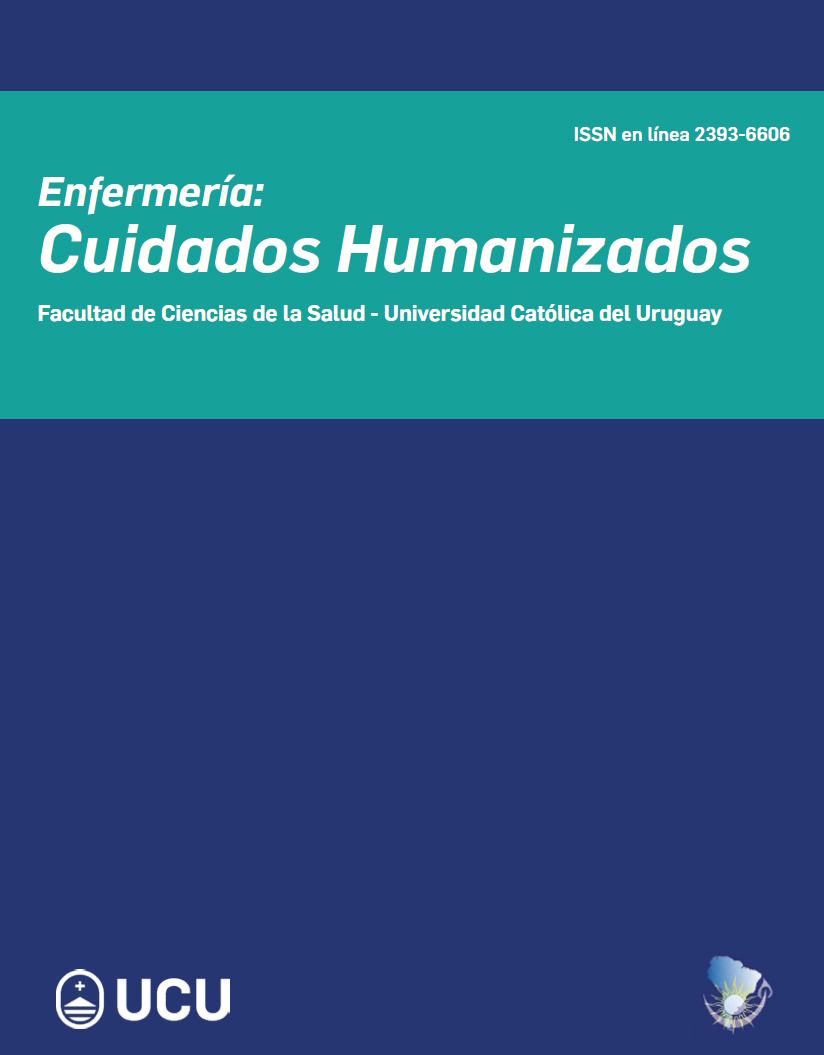Actitudes declaradas del personal de enfermería sobre sedación paliativa hospitalaria y ambulatoria: una revisión de alcance
DOI:
https://doi.org/10.22235/ech.v14i2.4469Palabras clave:
sedación, enfermería, actitudes, atención ambulatoria, cuidado paliativoResumen
Introducción: El rol de enfermería durante la sedación paliativa se centra en brindar un acompañamiento integral al paciente y la familia, al emplear esta terapia para el manejo de síntomas refractarios que no mejoran con los tratamientos convencionales. Objetivo: Explorar las actitudes declaradas del personal de enfermería frente a la sedación paliativa en los ámbitos hospitalarios y ambulatorios, según la literatura científica. Metodología: Se realizó la búsqueda en las bases de datos PubMed, Embase, Scopus y Science Direct, de artículos publicados entre 2018 y 2024, utilizando la metodología del Joanna Briggs Institute (JBI). Resultados: Se analizaron 15 artículos, organizando la información en las siguientes categorías: conocimientos específicos; factores asociados a creencias, valores y percepciones del personal de enfermería; y aspectos relacionados con el soporte emocional y las necesidades educativas. Discusión: El personal de enfermería en unidades de cuidados paliativos enfrenta desafíos vinculados al manejo del sufrimiento y la incertidumbre antes y durante la administración de la sedación paliativa, tanto en relación con el paciente como con su familia. Las actitudes frente a esta terapia varían según el contexto asistencial, ya sea hospitalario o ambulatorio. Conclusiones: La formación continua y el trabajo interdisciplinario son fundamentales para fortalecer la práctica de enfermería, reconociendo la sedación paliativa como una intervención importante para atender las necesidades del paciente y su familia. Además, el nivel de conocimiento sobre esta terapia varía en función de la experiencia previa y del entorno en el que se desempeña el profesional.
Descargas
Citas
1. De Araujo CZS, de Araújo LZS, Nassar Junior AP. Palliative sedation in patients with advanced cancer in a specialized unit in a middle-income country: A retrospective cohort study. Palliative Support Care [Internet]. 2022;20(4):491-495. doi: 10.1017/S1478951521001371
2. Caraceni A, Speranza R, Spoldi E, Ambroset CS, Canestrari S, Marinari M, et al. Palliative Sedation in Terminal Cancer Patients Admitted to Hospice or Home Care Programs: Does the Setting Matter? Results From a National Multicenter Observational Study. J Pain Symptom Manage. 2018;56(1):33-43. doi: 10.1016/j.jpainsymman.2018.03.008
3. World Health Organization. Palliative care [Internet]. WHO; 2020 [citado 2025 abr 9]. Disponible en: https://www.who.int/news-room/fact-sheets/detail/palliative-care
4. Heino L, Stolt M, Haavisto E. The practices of nurses about palliative sedation on palliative care wards: A qualitative study. J Adv Nurs [Internet]. 2022 [citado 2024 jul 26];78(11):3733-3744. doi: 10.1111/jan.15350
5. Piedrafita-Susín AB, Yoldi-Arzoz E, Sánchez-Fernández M, Zuazua-Ros E, Vázquez-Calatayud M. Percepciones, experiencias y conocimientos de las enfermeras sobre cuidados paliativos en las unidades de cuidados intensivos. Enferm Intensiva. 2015;26(4):153-165. doi: 10.1016/j.enfi.2015.06.001
6. Hernández Manzano CM, Angulo Ardoy M, Viloria Jiménez A. Conocimientos de los profesionales de Atención Primaria sobre recursos terapéuticos al final de la vida. Revista Española de Educación Médica [Internet]. 2024 [citado 2024 abr 1];5(2). doi: 10.6018/edumed.600401
7. Bhyan P, Pesce MB, Shrestha U, Goyal A. Palliative Sedation in Patients With Terminal Illness [Internet]. StatPearls Publishing, Treasure Island. 2023. PMID: 29262025 Disponible en: http://europepmc.org/abstract/MED/29262025
8. Peters MD, Godfrey C, McInerney P, Munn Z, Tricco AC, Khalil H. Scoping reviews. En: JBI Manual for Evidence Synthesis. JBI; 2024.
9. Lopez-Cortes OD, Betancourt-Núñez A, Bernal Orozco MF, Vizmanos B. Scoping reviews: una nueva forma de síntesis de la evidencia. Investigación en educación médica [Internet]. 2022 [citado 2024 mar 6];11(44):98-104. doi: 10.22201/fm.20075057e.2022.44.22447
10. Peters MDJ, Marnie C, Tricco AC, Pollock D, Munn Z, Alexander L, et al. Updated methodological guidance for the conduct of scoping reviews. JBI Evid Synth. 2020;18(10):2119-26. doi: 10.11124/JBIES-20-00167
11. Equator Network. Enhancing the QUAlity and Transparency Of health Research [Internet]. UK EQUATOR Centre; 2025 [citado 2024 jun 1]. Disponible en: https://www.equator-network.org/
12. Page MJ, McKenzie JE, Bossuyt PM, Boutron I, Hoffmann TC, Mulrow CD, et al. The PRISMA 2020 statement: an updated guideline for reporting systematic reviews. BMJ. 2021;372. doi: 10.1136/bmj.n71
13. Mengual TE, Chover-Sierra E, Ballestar-Tarín ML, Saus-Ortega C, Gea-Caballero V, Colomer-Pérez N, et al. Knowledge about Palliative Care and Attitudes toward Care of the Dying among Primary Care Nurses in Spain. Healthcare [Internet]. 2023 [citado 2024 jul 26];11(7):1018. doi: 10.3390/healthcare11071018
14. Meesters S, Bazata J, Handtke V, Gehrmann J, Kurkowski S, Klein C, et al. “It’s pretty much flying blind in the home care setting”: A qualitative study on the influence of home care specific circumstances on sedation in specialist palliative home care. Palliat Med [Internet]. 2023 [citado 2024 jul 26];37(1):140-148. doi: 10.1177/02692163221128938
15. Vivat B, Bemand-Qureshi L, Harrington J, Davis S, Stone P. Palliative care specialists in hospice and hospital/community teams predominantly use low doses of sedative medication at the end of life for patient comfort rather than sedation: Findings from focus groups and patient records for I-CAN-CARE. Palliat Med [Internet]. 2019 [citado 2024 jul 27];33(6):578-88. doi: 10.1177/0269216319826007
16. Robijn L, Seymour J, Deliens L, Korfage I, Brown J, Pype P, et al. The involvement of cancer patients in the four stages of decision-making preceding continuous sedation until death: A qualitative study. Palliat Med [Internet]. 2018 [citado 2024 jul 27];32(7):1198-1207. doi: 10.1177/0269216318770342
17. Vieille M, Dany L, Coz P Le, Avon S, Keraval C, Salas S, et al. Perception, Beliefs, and Attitudes Regarding Sedation Practices among Palliative Care Nurses and Physicians: A Qualitative Study. Palliat Med Rep [Internet]. 2021 [citado 2024 jul 27];2(1):160-167. doi: 10.1089/pmr.2021.0022
18. Zuleta‐Benjumea A, Muñoz SM, Vélez MC, Krikorian A. Level of knowledge, emotional impact and perception about the role of nursing professionals concerning palliative sedation. J Clin Nurs [Internet]. 2018 [citado 2024 jul 27];27(21-22):3968-3978. doi: 10.1111/jocn.14582
19. Grüne B, Meesters S, Bausewein C, Schildmann E. Challenges and Strategies Regarding Sedation at the End of Life in Hospitals and Nursing Homes. J Pain Symptom Manage [Internet]. 2022 [citado 2024 jul 27];63(4):530-538. doi: 10.1016/j.jpainsymman.2021.12.012
20. Meesters S, Grüne B, Bausewein C, Schildmann E. «We don’t want to sedate him»: A qualitative interview study on intentions when administering sedative drugs at the end of life in nursing homes and hospitals. BMC Palliat Care [Internet]. 2021 [citado 2024 jul 27];20(1). doi: 10.1186/s12904-021-00832-0
21. Robijn L, Deliens L, Rietjens J, Pype P, Chambaere K, Bowers BJ. Barriers in the Decision Making About and Performance of Continuous Sedation Until Death in Nursing Homes. Gerontologist [Internet]. 2020 [citado 2024 jul 27];60(5):916-925. doi: 10.1093/geront/gnz165
22. Lokker ME, Swart SJ, Rietjens JAC, van Zuylen L, Perez RSGM, van der Heide A. Palliative sedation and moral distress: A qualitative study of nurses. Appl Nurs Res [Internet]. 2018 [citado 2024 jul 27];40:157-161. doi: 10.1016/j.apnr.2018.02.002
23. Santos CG Dos, Faria ME De, Sant’Ana RSE, Bastos RA, Rodrigues JRP de L, Campos CJG, et al. Psychological Fantasies about the Administration of Palliative Sedation to Terminal Cancer Patients: A Qualitative Study of Reports from Brazilian Nurses in a Specialized Hospital. Preprints.org. 2023 [citado 2024 jul 27]. doi: 10.20944/preprints202306.1336.v1
24. Koksvik GH, Richards N, Gerson SM, Materstvedt LJ, Clark D. Medicalisation, suffering and control at the end of life: The interplay of deep continuous palliative sedation and assisted dying. Health (London) [Internet]. 2022 [citado 2024 jul 27];26(4):512-531. doi: 10.1177/1363459320976746
25. Bowers B, Pollock K, Barclay S. Unwelcome memento mori or best clinical practice? Community end of life anticipatory medication prescribing practice: A mixed methods observational study. Palliat Med [Internet]. 2022 [citado 2024 jul 27];36(1):95-104. doi: 10.1177/02692163211043382
26. Guité-Verret A, Boivin J, Hanna AMR, Downar J, Bush SH, Marcoux I, et al. Continuous palliative sedation until death: a qualitative study of palliative care clinicians’ experiences. BMC Palliat Care [Internet]. 2024 [citado 2024 jul 27];23(1):1-11. doi: 10.1186/s12904-024-01426-2
27. Bhyan P, Pesce MB, Shrestha U, Goyal A. Palliative sedation in patients with terminal illness. En: StatPearls [Internet]. Treasure Island, FL: StatPearls Publishing; 2025 [citado 2025 abr 9]. Disponible en: https://www.ncbi.nlm.nih.gov/books/NBK470545/
28. Yamamoto K, Yonekura Y, Nakayama K. Healthcare providers’ perception of advance care planning for patients with critical illnesses in acute-care hospitals: a cross-sectional study. BMC Palliat Care [Internet]. 2022 [citado 2025 abr 9];21(1):7. doi: 10.1186/s12904-021-00900-5
29. Govind N, Ferguson C, Phillips JL, Hickman L. Palliative care interventions and end-of-life care as reported by patients’ post-stroke and their families: a systematic review. European Journal of Cardiovascular Nursing [Internet]. 2023 [citado 2025 abr 9];22(5):445-453. doi: 10.1093/eurjcn/zvac112
30. Chen X, Zhang Y, Arber A, Huo X, Liu J, Sun C, et al. The training effects of a continuing education program on nurses’ knowledge and attitudes to palliative care: a cross sectional study. BMC Palliat Care [Internet]. 2022 [citado 2025 abr 9];21(1):56. doi: 10.1186/s12904-022-00953-0
Descargas
Publicado
Cómo citar
Número
Sección
Licencia
Derechos de autor 2025 Enfermería: Cuidados Humanizados

Esta obra está bajo una licencia internacional Creative Commons Atribución 4.0.

















